
There’s Something In My Eye!
October 22, 2020

“Ouch! It feels like there is something in my eye!” … We have all been there.

This feeling is called foreign body sensation. The eye might feel gritty, like there is sand in the eye. It is usually painful or uncomfortable with blinking since the eyelid rubs against the eyeball with every blink. Most people also have associated redness, light sensitivity, and blurred vision. Excessive tearing usually occurs as a natural reflex in response to the irritation, which tries to help flush out the particle. The following conditions are some of the most common causes of foreign body sensation.
Foreign Body
This is the most common and obvious cause of an individual feeling like something is in the eye (because there actually is something on the surface of the eye). An eyelash, dust or dirt particle, gnat or small flying bug, makeup, or crusty debris in the corner of the eyes are the frequent culprits of foreign body sensation. When this is the case, it is best to rinse the eye with saline to flush out the irritant. However, objects that are more dangerous can become lodged into the cornea, or front surface of the eye. Even the tiniest speck of metal or wood can cause severe symptoms and requires emergent attention by an eye care provider. Removing a foreign body becomes more difficult the deeper it is embedded into the cornea, and it also increases the risk of infection and scarring.
Contact Lens-Related Problem
Contact lens abuse can lead to a variety of complications, all which may cause foreign body sensation. Pain, watering, and light sensitivity are additional symptoms that are usually associated with contact lens-related problems. The most serious issue is a corneal ulcer. This needs to be addressed quickly to minimize the risk of infection and corneal scarring. Prolonged contact lens wear can also cause localized corneal swelling. Some individuals develop a sensitivity to the contact lens material, which causes cobblestone-like bumps under the upper eyelid, called giant papillary conjunctivitis (GPC). After the contact lenses are removed, the GPC bumps can be felt rubbing against the cornea during each blink. It is best to remove the contact lenses and call an eye doctor if you are having symptoms related to contact lens wear.
Corneal Abrasion
A corneal abrasion is a scratch to the outermost layer of the cornea. Signs and symptoms vary based on the severity of the injury. While the symptoms typically match those associated with the presence of a foreign body, it is possible for a foreign body particle to cause a corneal abrasion. Mild abrasions heal quickly with lubricating artificial tears. On the other hand, larger abrasions require antibiotic drops to minimize the risk of infection. Pupil-dilating drops can also help with pain in severe cases. Wearing protective eyewear when working in dusty environments or using power tools not only protects from particles flying into the eye, but also from associated corneal abrasions.
Ocular Allergies
A common complaint of people with ocular allergies is the feeling of grittiness or sand in the eyes. Itchiness is usually experienced as well, however, this can fluctuate from person to person. The membrane on the inside of the eyelid becomes inflamed and irritated with little bumps full of itch-causing histamine, which can rub against the eyeball. Some people find oral anti-histamine allergy medication helps alleviate the itching and foreign body sensation, but most people benefit even more with the use of a topical anti-histamine eye drop.
Dry Eye Syndrome
Symptoms of dry eye syndrome are very similar to that of ocular allergies. Some people may also experience quick, sharp spurts of pain related to corneal dryness. The cornea is packed with nerve endings that can make mildly dry eyes feel quite irritated. Artificial tears are the easiest treatment for dry eyes, but that might not be enough in some cases. There are prescription eye drops and other treatment strategies that can be utilized in addition to artificial tears.
Hordeolum
A hordeolum (AKA “stye”) is a tender, red bump on the eyelid. It can be on the inside part of the eyelid or visible on the external side. An oil gland becomes blocked and infected, which results in the swollen bump. During each blink, this area rubs against the eye and causes the sensation that something is in the eye. While this may cause pain to the actual eyelid where the hordeolum is located, it may also cause mild irritation to the surface of the eye.
Trichiasis
Trichiasis is a condition that occurs when the eyelashes grow inward towards the eye and typically causes many pinpoint abrasions or scratches to the eye. Some people are born with misdirected eyelashes, while others may develop this condition with age-related changes to the eyelids. An eye doctor can epilate (or pluck) the lashes in the office. It is easier, and safer, to have an eye doctor pull the lashes since we have a large, magnifying light source to accurately target the offending lash without taking several others in the process.
If there is ever a concern whether or not something is stuck in your eye, call our office to schedule a medical visit. Our specialized equipment allows us to examine and remove the tiniest, irritating foreign bodies. We are also able to diagnose any other conditions that may be contributing to a foreign body sensation. Stay safe and healthy!